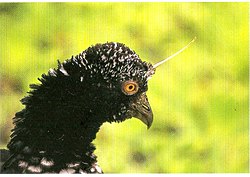| Horned screamer | |
|---|---|
 | |
| Three in Manu National Park, Peru | |
| Scientific classification | |
| Kingdom: | Animalia |
| Phylum: | Chordata |
| Class: | Aves |
| Order: | Anseriformes |
| Family: | Anhimidae |
| Genus: | Anhima Brisson, 1760 |
| Species: | A. cornuta |
| Binomial name | |
| Anhima cornuta (Linnaeus, 1766) | |
 | |
| Distribution map | |
| Synonyms | |
Palamedea cornutaLinnaeus, 1766 | |
The horned screamer (Anhima cornuta) is a species of bird that belongs to a relatively small family, the Anhimidae, which occurs in wetlands of tropical South America. There are three screamer species, the other two being the southern screamer and the northern screamer in the genus Chauna. They are related to ducks, geese and swans, which are in the family Anatidae, but have bills looking more like those of game birds.



